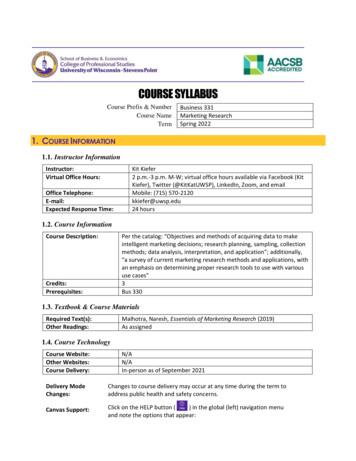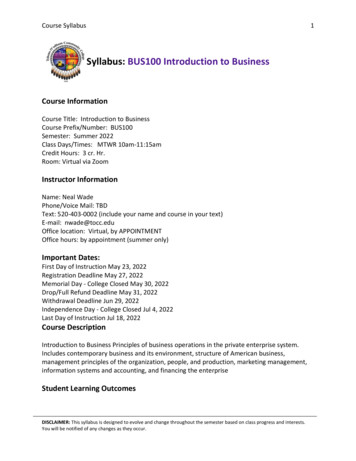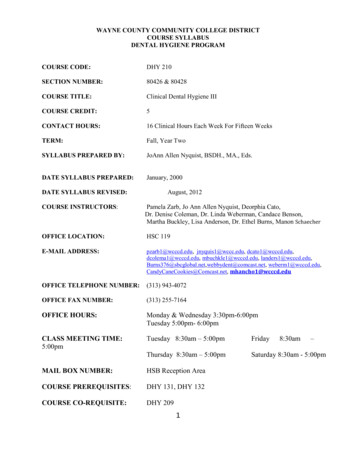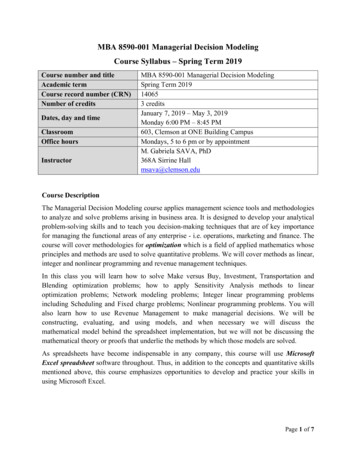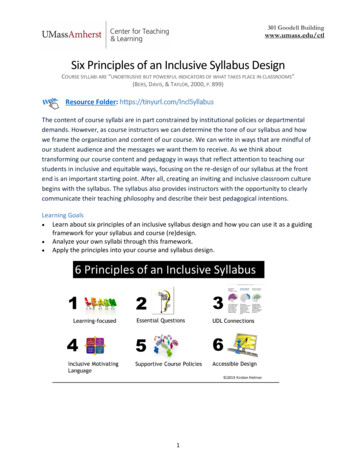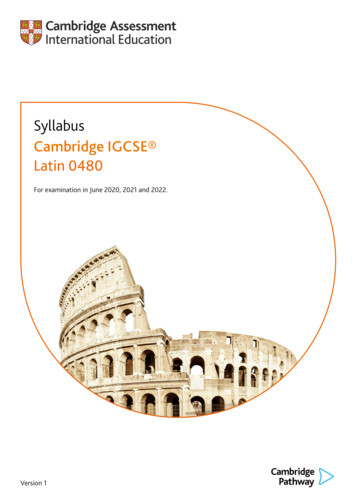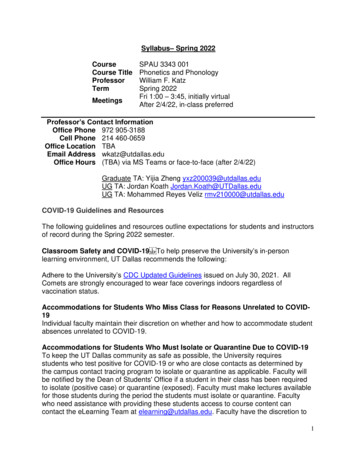
Transcription
Syllabus– Spring 2022CourseCourse TitleProfessorTermMeetingsSPAU 3343 001Phonetics and PhonologyWilliam F. KatzSpring 2022Fri 1:00 – 3:45, initially virtualAfter 2/4/22, in-class preferredProfessor’s Contact InformationOffice Phone 972 905-3188Cell Phone 214 460-0659Office Location TBAEmail Address wkatz@utdallas.eduOffice Hours (TBA) via MS Teams or face-to-face (after 2/4/22)Graduate TA: Yijia Zheng yxz200039@utdallas.eduUG TA: Jordan Koath Jordan.Koath@UTDallas.eduUG TA: Mohammed Reyes Veliz rmv210000@utdallas.eduCOVID-19 Guidelines and ResourcesThe following guidelines and resources outline expectations for students and instructorsof record during the Spring 2022 semester.Classroom Safety and COVID-19 To help preserve the University’s in-personlearning environment, UT Dallas recommends the following:Adhere to the University’s CDC Updated Guidelines issued on July 30, 2021. AllComets are strongly encouraged to wear face coverings indoors regardless ofvaccination status.Accommodations for Students Who Miss Class for Reasons Unrelated to COVID19Individual faculty maintain their discretion on whether and how to accommodate studentabsences unrelated to COVID-19.Accommodations for Students Who Must Isolate or Quarantine Due to COVID-19To keep the UT Dallas community as safe as possible, the University requiresstudents who test positive for COVID-19 or who are close contacts as determined bythe campus contact tracing program to isolate or quarantine as applicable. Faculty willbe notified by the Dean of Students' Office if a student in their class has been requiredto isolate (positive case) or quarantine (exposed). Faculty must make lectures availablefor those students during the period the students must isolate or quarantine. Facultywho need assistance with providing these students access to course content cancontact the eLearning Team at elearning@utdallas.edu. Faculty have the discretion to1
set an attendance policy for their in-person meetings, but the absences due to COVID19 cannot be counted against an isolated or quarantined student.Verifying COVID-19 Isolations or QuarantinesStudents need to self-report COVID-19 positive results or exposures via an onlineform so that university campus tracers can verify, record, and take necessary campusprecautions. When faculty are notified by students rather than by the Dean of Students'Office that the students are isolating or quarantining, the faculty should remind studentsto self-report via the form; students should not attend class until cleared by campustracers.Vaccinations are widely available, free and not billed to health insurance. The vaccinewill help protect against the transmission of the virus to others and reduce serioussymptoms in those who are vaccinated. You are encouraged to get a COVID-19vaccine and register your vaccination status through the voluntary vaccine report form.If you have received your COVID-19 booster, you may register your status through thevoluntary COVID- booster reporting form.Proactive Community Testing remains an important part of the university’s efforts toprotect our community. Tests are fast and free. Please check the Comets Unitedwebpage for additional information.Student Safety remains an important part of the UT Dallas’ efforts to protect ourcommunity. All students will adhere to the Comet Commitment. Unvaccinated Cometswill be expected to complete the mandatory Required Daily Health Screening. Thosestudents who do not comply will be referred to the Office of Community Standards andConduct for disciplinary action under the Student Code of Conduct – UTSP5003. Allstudents are encouraged to read the Recommendations for Students Returning toCampus issued on August 2, 2021.Visit Comets United webpage to obtain the latest information on the University’sguidance and resources for campus health and safety.Previous Campus Communications: a list of university announcements made in 20202022.Registrar's Intranet: please log in with your UTD NetID and password to access this site.Information that faculty need about grading, scheduling, and other essential aspects ofour responsibilities related to teaching are made available and updated regularly in theRegistrar's Intranet. This source of information can only be accessed by logging in withyour UTD NetID and password. Many important faculty questions are answered here,and this is information that faculty members are expected to know and understand.FERPA Guidelines: you will be asked to log in before you access the FERPA Guidelineswebpage on the Registrar's Intranet. If faculty have additional questions about FERPAguidance, please contact the Office of the Registrar at records@utdallas.edu for the2
proper student consent forms and further instructions. NOTE: Class recordings fromprior semesters may be used as long there are no identifiable student information dueto FERPA because instructors will need students’ written consent first. Please reviewyour previous class recordings for identifiable student information before using them inthe current term. For additional guidance, contact the Office of the Registrar.Honorlock: Online proctoring tool will be available for fully online courses and forclasses with enrolled international students who are not yet in the United States.UT System Resources for Creating Accessible Course Content: designed to assistfaculty with developing course contentStudent ResourcesStudents who have tested positive for COVID-19 or may have been exposed should notattend class in person and should instead follow required disclosure notifications asposted on the university’s website (see "Student Safety" protocols).COVID-19 ResourcesComets United webpage: check frequentlyFAQ: check out the FAQs and reach out to your instructor or academic advisor ifanswers are not includedStudent Resources: a variety of resources are available to help students to obtaincounseling, health care, and academic support.Course Pre-requisites, Co-requisites, and/or Other RestrictionsNone.Course DescriptionThis course provides an overview of modern phonetics. We will cover articulatory,acoustic, and linguistic phonetic theories. Students will acquire basic transcriptionskills, with particular attention paid to foreign-accented English and the speech ofindividuals with communication disorders.Student Learning Objectives/OutcomesThis course has been designed to ensure that students demonstrate required knowledge andskill as outlined in the Standards and Implementation Guidelines for the Certificate ofClinical Competence in Speech-Language Pathology. The specific standards addressed inthis class are: III-B, III-C, III-E, IV-B, IV-G.After completing the course students should be able to:1) Identify the anatomy of the speech production mechanism. (III-B)3
2) Discuss and explain articulatory phonetics, including feature theory and the basickinematics of tongue, lip, jaw, and velum. (III-B)3) Recognize the importance of voicing and voice mechanisms. (III-B)4) Show abilities of basic IPA transcription, including composing an effective transcript,constructing clear examples of spontaneous and citation form speech transcripts, andinterpreting read transcriptions. (III-B, III-C, IV-B, IV-G).5) Analyze and classify the consonants and vowels of American English by the features ofplace, manner, and voicing. (III-B).6) Discuss the phonological rules and allophones of American English and contrast these withsystems for other accents and languages. This will incorporate systems of stress andintonation. (III-B, III-C).7) Identify and apply properties of acoustic phonetics to speech pathology practice. (III-C, IIIE, IV-B, IV- G).8) Define and outline the basic principles of linguistic phonetics. (III-B, III-C)ASHA STANDARDS ADDRESSED IN THIS CLASS: How knowledge isconveyed and how knowledge and skill acquisition will be demonstrated:Standard III-BThe applicant must demonstrate knowledge of basic human communication andswallowing processes including their biological, neurological, acoustic, psychological,developmental, linguistic and cultural bases. Specific knowledge will be demonstratedin this class in the area of phonetics.Knowledge will be conveyed via class lectures and readings.Acquisition will be demonstrated via class discussions, exams and required project.Standard III-CThe applicant must demonstrate knowledge of the nature of speech, language, hearing, andcommunication disorders and differences and swallowing disorders, including the etiologies,characteristic, anatomic/physiological, acoustic, psychological, developmental, and linguisticand cultural correlates.Specific knowledge will be demonstrated in this class in phonetics.Knowledge will be conveyed via class lectures, readings, and required videotape viewing.Acquisition will be demonstrated via class discussions, required quizzes over videotapes,and final project.Standard III-EThe applicant must demonstrate knowledge of standards of ethical conduct.Knowledge will be conveyed via class lectures. Acquisition will be demonstrated via classdiscussion.4
Standard IV-BThe applicant must possess skill in oral and written communication sufficient for entryinto professional practice.Acquisition of knowledge will be demonstrated via written final project.Standard IV-GThe applicant for certification must complete a program of study that includes supervisedclinical experiences sufficient in breadth and depth to achieve the following skills outcomes(in addition to clinical experiences, skills may be demonstrated through successfulperformance on academic coursework and examinations, independent projects or otherappropriate alternative methods). Specific knowledge will be demonstrated in this class inthe area of phonetics.Knowledge will be conveyed via lectures and readings. Acquisition will bedemonstrated via class discussion and final project.Students will demonstrate the following skills:1. Discuss and explain theories concerning the anatomy and physiology of the speechproduction mechanism. As measured by:Successful completion of exams andhomework assignments, class discussion2. Describe and apply the principles of articulatory phonetics, including use of feature theoryto describe the sounds of General American English (GAE) and other languages.As measured by:Successful completion of exams andhomework assignments, class discussion,final project3. Demonstrate understanding of voicing and voice mechanisms, including the concept ofpartial devoicing as it relates to phonological rules.As measured by:Successful completion of exams andhomework assignments, class discussion,final project4. Demonstrate the ability of use IPA transcription, including composing an effectivetranscript, constructing clear examples of spontaneous and citation form speech transcripts,and interpreting read transcriptions.As measured by:Successful completion of exams andhomework assignments, class discussion,final project5. Analyze and classify the consonants and vowels of American English by the features ofplace, manner, and voicing.As measured by:Successful completion of exams andhomework assignments, class discussion,final project5
6. Discuss the phonological rules and allophones of American English and contrast thesewith systems for other accents and languages. This will incorporate systems of stress andintonationAs measured by:Successful completion of exams andhomework assignments, class discussion7. Apply properties of acoustic phonetics to speech pathology practice, includingtranscription of foreign- accented English.As measured by:Successful completion of exams andhomework assignments, class discussion,final project8. Interpret the basic principles of linguistic phonetics and apply them to the clinicalissue of phonemic misperception and L2 acquisition.As measured by:Successful completion of exams andhomework assignments, class discussionRequired Textbooks and MaterialsTextbook: Katz, William F. (2013). Phonetics for Dummies. John Wiley & Sons.ISBN# 978-1118505083 [Note: updated 2017]Alternate Access: The text is also available as an eBook. For more details, seehttps://www.wiley.com/en-us/Phonetics For Dummies-p-9781118505090Materials: All additional course materials are made available in eLearning or via classwebsite: ching/courses/phonetics/Suggested Course MaterialsTranscribing American English – Instructional videos made for our ab/teaching/instructional-materials/Alvin2 – A self-paced phonetics learning program by Prof. James H. Hillenbrand. ForPC only. https://homepages.wmich.edu/ hillenbr/iPA Phonetics - iphone application. Download from App Store (free). By C. Coey,J.H. Esling, S.R. Moisik, Univ. Victoria, Department of Linguistics (2019).Recommended optional books Cancio, M.L. & Singh, S. (2020). Functional Phonetics Workbook, Third Edition. Ladefoged, P. & Johnson, K. (2015). A Course in Phonetics. 7th EditionAssignments & Academic Calendar (next page)6
Assignments & Academic Calendar* Last day to drop without a ‘W’ 2/22Week/DateLecture/PPT(1)1/21Blue Virtual, Black Face-to-face (tentative)LabWhat’s due and(part of eachwhat to study for:Fri session)HW homeworkLM learning moduleFirst meetingBasics of GAEIntro Chap. 1 & 2Review syllabus, text, website,consonantscoursework expectations. Broad(wk)introduction to the coursework.(2)1/28Source-filter theory IPAPlace and manner of consonantsVowel symbols and pronunciationGAE vowels anddiphthongs(wk)Chap. 3 & 4(3)2/4Feature theory, continuesegmentals, beginsuprasegmentalsChap. 1- 4LM1: Intonation & VPM (duestart of class on e-learning(4)2/11(5)2/18Concepts of phoneme andallophone, complimentary/freedistribution, broad/narrowtranscriptionCover last points in chapters 1-4Airstream mechanisms, demos anddiscussion of these soundsLab 1:IntonationpracticeVPM practiceLab 2: Broadtranscription(6)2/25Place and manner of languagesother than EnglishLab 4: Broadtranscription(7)3/413 phonological rules of GAEApplications for SLP, use ofdiacritics(8)3/11“power week”TBAPractice applying 13 rulesMidterm review - mock examAsynchronous or with Prof/TAprevious to Fri class“Catch-up” lab pair/shareactivity w/ 13phonol. rulesLab 5: NarrowtranscriptionAsynchronousor with Prof/TAprevious to FriclassLab 3: BroadtranscriptionChap. 5, 6 & 7LM 2: Broad transcriptionHW 1 -both due on e-learningQuiz 1: 10 words- intonationChap. 15LM 3: Real word transcriptionHW2 -both due on e-learningQuiz 2: Broad, 5 real wordsProject audio files assignedChap. 16LM 4: Non-word transcriptionHW3 -both due on e-learningQuiz 3: Broad, 5 non-wordChap. 8, 9LM 5: Transcription practice 1HW4 - both due on e-learning13 rules worksheet3/11 Midterm examIn class (synchronous)3/14 to 3/20 - SPRING BREAK(9)3/25Continue with narrow transcriptionBegin using intonation contoursLab 6: Varietiesof English accents/dialectsLM 6: Narrow transcriptiondue on e-learningVideo: “American Tongues”7
(10)4/1Varieties of EnglishAmerican vs. British; Mappingregional differences, tips fortranscription. Issues in SLP practiceLab 7: NarrowTranscriptionChap. 18LM 7: Narrow transcriptionon e-learning(11)4/8Intonation contours, tonic stress,and primary/secondary stress.Syllable- vs. stress-timedlanguages. Sonority/prominence.Stress, length, geminateconsonants, and extra-long vowels.Phonemic toneAcoustic phoneticsNature of sound, wave theory,harmonics and formants. Briefdemo of Praat, speech analysissoftwareLab 8:Intonationcontours/primary,secondarystressChap. 10, 11LM 8: Lexical stress, intonationon e-learning(12)4/15(13)4/22(14)4/29Last Fri ofclassesLast day ofclasses(Tentative)Acoustics cont’d / Spectrograms:brief history, axes, how to interpretvowels/diphthongs consonantsPerceptual acoustics: categoricalperception, VOT, ease ofarticulation, perceptualdistinctivenessLab 9: NarrowTranscription:Sentence leveltranscriptionAssign mysteryspectrogramLab 10: NarrowTranscription,sentence leveltranscriptionReview mysteryspectrogram inlabChap. 12,13LM 9: Transcription practice 2Quiz 4: Narrow, 10 words -- bothdueChap. 12,13 &14LM 10: Sentence transcriptionHW5 – both due on e-learningMystery spectrogramSpecial PopulationsAdult neurogenic speech, children’sspeechReviewChap. 17&19transcriptiondue on e-learningissues for finalprojectFinal project dueThursday (5/05) on e-learning by 5:00 pmFinal Exam - Friday, 5/13 - In class (synchronous)8
Grading PolicyGrading Breakdown: 25% quizzes/homework; 25% midterm; 25% final; 25% final project.Grade scale: 98-100, A ; 93-97, A; 90-92, A-; 88-89, B ; 83-87, B; 80-82, B-; 78-79, C ; 73- 77, C;70-72, C-; 68-69, D ; 63-67, D; 60-62, D-; below 60, F.Retain your best homework/quiz scoresTo cover any contingencies that might affect performance on a single homework assignment or quizscore, we allow you to drop a lowest homework and lowest quiz score from your semester average.Extra Credit OpportunitiesExtra credit may be earned by completing the exercises from online learning modules on eLearning.Learning module (LM) exercises are graded based on effort, not accuracy. Completion of the first fiveLM exercises will add five points to your midterm exam grade; completion of the second set of five willadd five points to your final exam grade. You must complete all five LM exercises in the set to receivefull extra credit. Four exercises or less merits partial credit, as set by the instructor.Course & Instructor PoliciesHomework assignments will not be accepted late. If you must miss a quiz or exam, notify theinstructor as soon as possible. Missed quizzes and exams will only be given in cases of legitimate,documented reasons (e.g., illness with a doctor’s note) and must be made-up within a week of theoriginal date. For the final project, five points will be deducted from late submissions for each daythat has passed since the deadline. Late extra credit submissions will not be accepted.Knowledge is assessed throughout the semester via homework assignments, quizzes, and weeklylab exercises. There will be a midterm exam, a (cumulative) final, and a final project.Homework: Homework assignments assess your understanding of the material we have coveredduring lecture. Instructions for each assignment will be posted on eLearning. All assignments mustbe completed independently (unless otherwise specified). Late assignments will not be accepted.Quizzes: Quizzes will assess your transcription abilities as the course progresses. For each quiz,you will be asked to independently transcribe the speech samples that you hear.Exams: Exams will assess your knowledge and understanding of the conceptual informationpresented in the text and during lectures. The final exam is cumulative, and will cover material fromthe entire course. For each exam, you will have a study guide to help you prepare.Class MaterialsThe instructor may provide class materials that will be made available to all students registered forthis class as they are intended to supplement the classroom experience. These materials may bedownloaded during the course, however, these materials are for registered students' use only.Classroom materials may not be reproduced or shared with those not in class, or uploaded to otheronline environments except to implement an approved Office of Student AccessAbilityaccommodation. Failure to comply with these University requirements is a violation of the StudentCode of Conduct.9
Classroom Conduct Requirements Related to Public Health MeasuresUT Dallas will follow the public health and safety guidelines put forth by the Centers for DiseaseControl and Prevention (CDC), the Texas Department of State Health Services (DSHS), and localpublic health agencies that are in effect at that time during the Spring 2022 semester to the extentallowed by state governance. Texas Governor Greg Abbott’s Executive Order GA-38 prohibits usfrom mandating vaccines and face coverings for UT Dallas employees, students, and members of thepublic on campus. However, we strongly encourage all Comets to get vaccinated and wear facecoverings as recommended by the CDC. Check the Comets United: Latest Updates webpage for thelatest guidance on the University’s public health measures. Comets are expected to carry out StudentSafety protocols in adherence to the Comet Commitment. Unvaccinated Comets will be expected tocomplete the Required Daily Health Screening. Those students who do not comply will be referred tothe Office of Community Standards and Conduct for disciplinary action under the Student Code ofConduct – UTSP5003.Class AttendanceThe University’s attendance policy requirement is that individual faculty set their course attendancerequirements. Regular and punctual class attendance is expected. Students who fail to attend classregularly are inviting scholastic difficulty. In some courses, instructors may have special attendancerequirements; these should be made known to students during the first week of classes. Faculty havethe discretion to set an attendance policy for their in-person meetings, but the absences due toCOVID-19 cannot be counted against a quarantined student.Class ParticipationRegular class participation is expected. Students who fail to participate in class regularly areinviting scholastic difficulty. A portion of the grade for this course is directly tied to yourparticipation in this class. It also includes engaging in group or other activities during classthat solicit your feedback on homework assignments, readings, or materials covered in thelectures (and/or labs). Class participation is documented by faculty. Successful participationis defined as consistently adhering to University requirements, as presented in this syllabus.Failure to comply with these University requirements is a violation of the Student Code ofConduct.Class RecordingsStudents are expected to follow appropriate University policies and maintain the security ofpasswords used to access recorded lectures. Unless the Office of Student AccessAbility hasapproved the student to record the instruction, students are expressly prohibited from recording anypart of this course. Recordings may not be published, reproduced, or shared with those not in theclass, or uploaded to other online environments except to implement an approved Office of StudentAccessAbility accommodation. Failure to comply with these University requirements is a violation ofthe Student Code of Conduct.NOTE: if the instructor records any part of the course, then the instructor will need to add thefollowing syllabus statement:The instructor may record meetings of this course. These recordings will be made availableto all students registered for this class if the intent is to supplement the classroom10
experience. If the instructor or a UTD school/department/office plans any other uses for therecordings, consent of the students identifiable in the recordings is required prior to suchuse unless an exception is allowed by law.Off-campus Instruction and Course Activities(Below is a description of any travel and/or risk-related activity associated with this course.)Comet CreedThis creed was voted on by the UT Dallas student body in 2014. It is a standard that Comets chooseto live by and encourage others to do the same:“As a Comet, I pledge honesty, integrity, and service in all that I do.”Academic Support ResourcesThe information contained in the following link lists the University’s academic support resources for allstudents.Please see UT Dallas Syllabus Policies and ProceduresThe information contained in the following link constitutes the University’s policies and proceduressegment of the course syllabus. Please review the catalog sections regarding the credit/no credit orpass/fail grading option and withdrawal from class.Please go to http://go.utdallas.edu/syllabus-policies for these policies.The descriptions and timelines contained in this syllabus are subject to change at the discretion of theProfessor.11
Course SPAU 3343 001 Course Title Phonetics and Phonology Professor William F. Katz Term Spring 2022 Meetings Fri 1:00 - 3:45, initially virtual After 2/4/22, in-class preferred Professor's Contact Information Office Phone 972 905-3188 Cell Phone 214 460-0659 Office Location TBA Email Address wkatz@utdallas.edu



